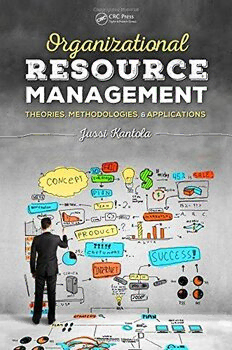
Organizational Resource Management: Theories, Methodologies, and Applications PDF
Preview Organizational Resource Management: Theories, Methodologies, and Applications
Boca Raton London New York CRC Press is an imprint of the Taylor & Francis Group, an informa business CRC Press Taylor & Francis Group 6000 Broken Sound Parkway NW, Suite 300 Boca Raton, FL 33487-2742 © 2016 by Taylor & Francis Group, LLC CRC Press is an imprint of Taylor & Francis Group, an Informa business No claim to original U.S. Government works Version Date: 20150909 International Standard Book Number-13: 978-1-4398-5164-7 (eBook - PDF) This book contains information obtained from authentic and highly regarded sources. Reasonable efforts have been made to publish reliable data and information, but the author and publisher cannot assume responsibility for the validity of all materials or the consequences of their use. The authors and publishers have attempted to trace the copyright holders of all material reproduced in this publication and apologize to copyright holders if permission to publish in this form has not been obtained. If any copyright material has not been acknowledged please write and let us know so we may rectify in any future reprint. Except as permitted under U.S. Copyright Law, no part of this book may be reprinted, reproduced, transmitted, or utilized in any form by any electronic, mechanical, or other means, now known or hereafter invented, including photocopying, microfilming, and recording, or in any information stor- age or retrieval system, without written permission from the publishers. For permission to photocopy or use material electronically from this work, please access www.copy- right.com (http://www.copyright.com/) or contact the Copyright Clearance Center, Inc. (CCC), 222 Rosewood Drive, Danvers, MA 01923, 978-750-8400. CCC is a not-for-profit organization that pro- vides licenses and registration for a variety of users. For organizations that have been granted a photo- copy license by the CCC, a separate system of payment has been arranged. Trademark Notice: Product or corporate names may be trademarks or registered trademarks, and are used only for identification and explanation without intent to infringe. Visit the Taylor & Francis Web site at http://www.taylorandfrancis.com and the CRC Press Web site at http://www.crcpress.com This book is dedicated to all those who can see the world without sharp boundaries. Contents List of Figures ...........................................................................................................xi List of Tables ............................................................................................................xv Abstract ..................................................................................................................xvii Preface.....................................................................................................................xix Acknowledgments ................................................................................................xxiii Author ....................................................................................................................xxv Definitions Used in This Book ............................................................................xxvii Chapter 1 Introduction ..........................................................................................1 1.1 Nature of Organizational Resources .........................................4 1.1.1 What Are Our Organizational Resources Today? ........6 1.1.2 What Are the Elements in the Organizational Resources? ....................................................................7 1.1.3 How to Make Use of All Kinds of Organizational Resources for Management Purposes? .....................................................................9 1.1.4 How to Handle the Complexity of Organizational Resources for Management Purposes? .........................9 1.1.5 How to Have Transparent Current and Future Views on Organizational Resources? .........................10 1.2 Ingenious Management Propositions .......................................11 1.3 Resource Management Propositions .......................................13 1.4 Structure of the Book ..............................................................16 References ..........................................................................................17 Chapter 2 Framework for Organizational Resource Management .....................19 2.1 Proposition 1: Model Relevant Content ...................................19 2.1.1 Objects or Systems? ....................................................20 2.1.2 Types of Models .........................................................23 2.2 Proposition 2: Involve People ..................................................24 2.3 Proposition 3: Compute Meaning ............................................25 2.4 Proposition 4: Manage in the Context .....................................26 References ..........................................................................................27 Chapter 3 Evolute Approach ...............................................................................29 3.1 Proposition 1: Model with Ontologies .....................................30 3.1.1 Ontologies...................................................................30 3.1.2 Ontology Lifecycle .....................................................31 3.1.3 Ontology Development in Organizations ...................31 vii viii Contents 3.1.4 Ontology Repository ..................................................33 3.1.5 Ontology Presentation ................................................34 3.1.6 Ontology-Based Self-Evaluation ................................38 3.2 Proposition 2: Involve People with Modular Process ..............40 3.3 Proposition 3: Compute the Meaning with Fuzzy Logic ........43 3.3.1 Fuzzy Sets ..................................................................43 3.3.2 Linguistic Variables ...................................................44 3.3.3 Fuzzy Logic ................................................................46 3.3.4 Mapping Domains ......................................................47 3.3.5 Rule Bases ..................................................................51 3.3.6 Fuzzy Logic Application Modules .............................57 3.4 Proposition 4: Manage in the Context with Instances .............60 3.4.1 Instances .....................................................................60 3.4.2 Instance Vector ...........................................................66 3.4.3 Instance Matrix ..........................................................66 3.4.4 Dynamic Instance Matrix ..........................................67 3.4.5 Instance Representation and Visualization ................68 3.4.6 Ingenious Management ..............................................69 References ..........................................................................................74 Chapter 4 Pursoid: Innovation Competence of Human Resources .....................79 Hannu Vanharanta Abstract ..............................................................................................79 4.1 Introduction .............................................................................79 4.2 Metaphors, Constructs, Concepts, and Ontology Creation .....80 4.3 Innovation Evaluation Process ................................................83 4.4 Pursoid Tool .............................................................................84 4.5 Case .........................................................................................84 4.6 Results .....................................................................................85 4.7 Discussion ................................................................................88 References ..........................................................................................88 Chapter 5 Helix: Organizational Commitment and Engagement in Business Organizations ......................................................................91 Jarno Einolander Abstract ..............................................................................................91 5.1 Introduction .............................................................................91 5.2 Organizational Commitment and Engagement .......................92 5.3 Helix Tool ................................................................................93 5.4 Case .........................................................................................94 5.5 Results .....................................................................................94 5.6 Discussion ................................................................................97 References ..........................................................................................98 Contents ix Chapter 6 Kappa: Future Challenges for Sales Function ..................................101 Kari Ingman Abstract ............................................................................................101 6.1 Introduction ...........................................................................101 6.2 Importance of Culture for Sales Management ......................102 6.3 Sales Culture Ontology and Kappa Tool ...............................102 6.4 Case .......................................................................................106 6.5 Results ...................................................................................106 6.6 Discussion ..............................................................................110 References ........................................................................................110 Chapter 7 Chronos and Kairos: Understanding and Managing Time ..............111 Tero Reunanen Abstract ............................................................................................111 7.1 Introduction ...........................................................................111 7.2 Time in Managerial Environment .........................................112 7.3 Chronos and Kairos Tool .......................................................115 7.4 Case .......................................................................................117 7.5 Results ...................................................................................118 7.6 Discussion ..............................................................................120 References ........................................................................................120 Chapter 8 Organizational Resource Innovation ................................................123 References ........................................................................................126 Chapter 9 Other Approaches and Methods .......................................................127 References ........................................................................................129 Chapter 10 Discussion and Future Work ............................................................131 10.1 New Work Roles ....................................................................131 10.2 Instance-Based Meaning Interpreters ...................................132 10.3 Ontology Forums ...................................................................132 10.4 Open-Source Ontologies .......................................................132 10.4.1 Cultures and Languages ...........................................132 10.4.2 Tacit Knowledge .......................................................133 10.5 Change Management .............................................................134 References ........................................................................................134 Index ......................................................................................................................135
